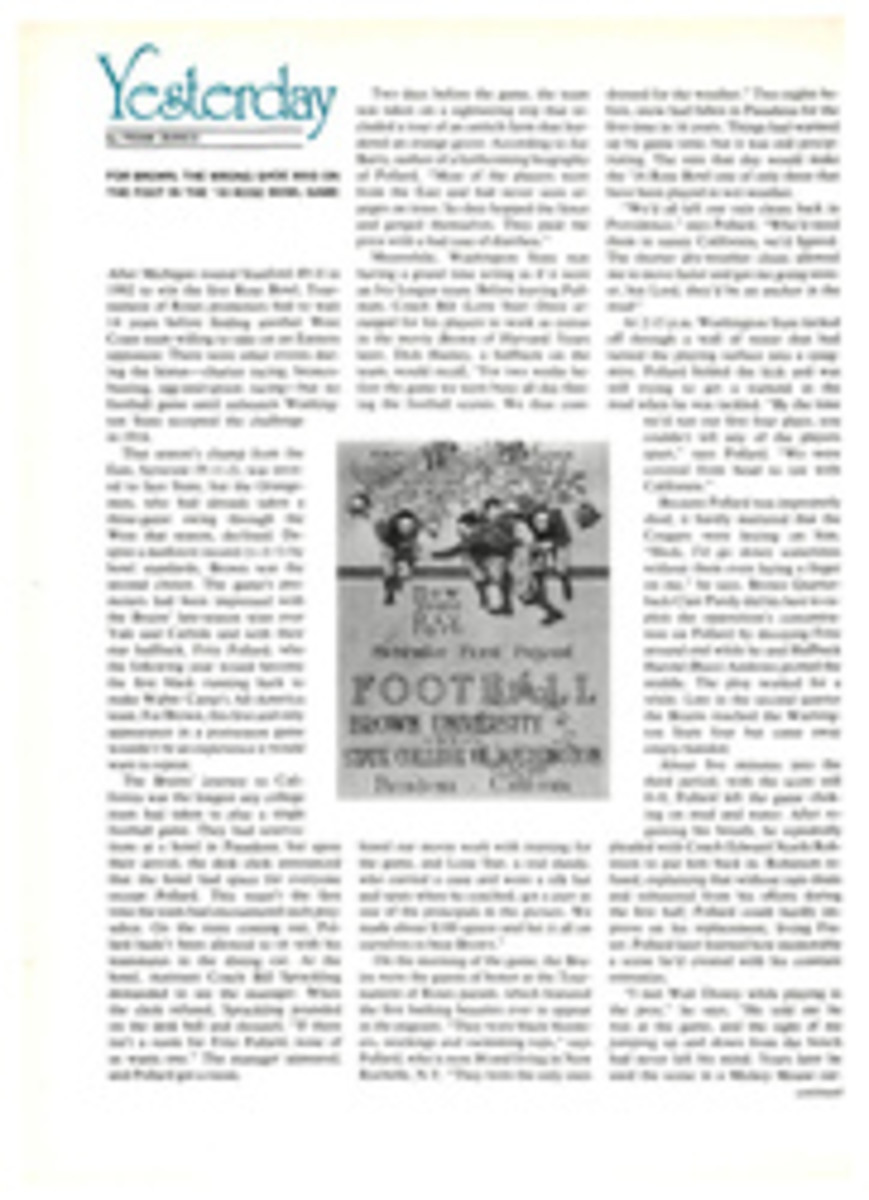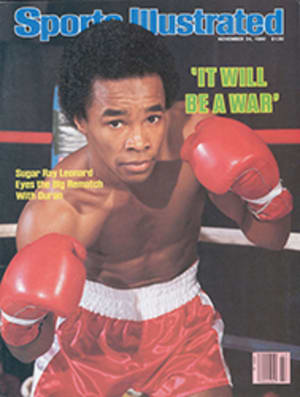
A real breath of fresh air
During the '70s, college football was dominated by run-oriented offenses—"You've got to establish that ground game first, Keith." Backs who gained 100 yards on a Saturday afternoon were commonplace. Wishbone, veer and power I became part of the game's jargon, as did the fullback belly series and USC's student-body right. But now the ground game is being challenged, perhaps even passed, if you will. Introducing the aerial circus: the run-and-shoot or the flare-flood control. No matter what their coaches may call the air attack, today's-quarterbacks are throwing the ball, throwing it so well, in fact, that the official NCAA 1980 Football Records book is in tatters.
Consider the action on Saturday, Nov. 8. Purdue's Mark Herrmann set what apparently was a Big Ten single-game passing record, 439 yards, except that Dave Wilson, playing for the Boilermakers' opponent that day, Illinois, broke it, throwing for 621 yards—which is also the NCAA single-game mark. As it turned out, Herrmann's 439 yards didn't give him even the bronze medal among that afternoon's passers. Also that day Ben Bennett, Duke's sensational freshman, passed for an ACC-record 469 yards and Brigham Young's Jim McMahon threw for 464. And though he only got 230 yards, Washington's Tom Flick was no slouch; he completed a record 16 of his 17 passes—or 94% of his attempts.
Overall, the day produced the wildest passing statistics of the season—an average of 328 yards a game. And that number doesn't include the feats of Neil Lomax, Portland State's marvel, who breaks a Division I-AA record every time he throws a pass or completes one. In a 105-0 triumph over Delaware State, Lomax threw eight touchdown passes, a dizzying seven of them in the first quarter.
Last Saturday it more or less happened again. Wake Forest's Jay Venuto nearly broke Bennett's record, throwing for 447 yards, and Lomax for 448 yards, including his record 101st touchdown pass. Wilson brought his two-week passing total to more than 1,000 yards, with a 403-yard performance. Meanwhile, McMahon completed 23 passes for another 441 yards, giving him 3,834 for the season. With two games still to play, he shouldn't have any trouble becoming the first major college player to pass for 4,000 yards in a season. With McMahon doing the pitching, Brigham Young is averaging 416.2 passing yards, 42 more than the NCAA Division I-A team record set by San Diego State in 1969, and Lomax' team is rolling up an even better 422.6 a game.
Career passing records are falling every week, too. In the Midwest, Herrmann has exceeded the major-college career passing-yardage mark with 8,865. Down South, Tennessee State's Joe Adams, who has 8,300 career passing yards, threw for three touchdowns Saturday, increasing his four-year total to 77, eight more than the 11-year-old Division I-A record established by North Texas State's Steve Ramsey. Out West, the collegiate career of California's Rich Campbell ended abruptly three weeks ago with an injury to his left knee. But before it did he set the Division I-A season mark for completion percentage (70.7%) and broke Roger Staubach's career accuracy record (for 400 attempts or more) by connecting on 64.4% of his throws. Also, the single-season record of 296 completions, set by Bill Anderson of Tulsa in 1965, is in jeopardy. McMahon already has hit on 242 passes.
All this has the NCAA Statistics Service in Shawnee Mission, Kans. on red alert. The emphasis on passing this season has risen from 30.5% to 32.7% of all offensive plays, the greatest swing from one season to the next since the two-platoon era began in 1965. Moreover, the rise in passing yardage per major-college game (24.2 yards, both teams combined) is expected to be the largest since 1958. And that year passing had its greatest increase ever. (Actually, larger increases occurred in 1949, 1965 and 1968, but in those years new rules brought about big jumps in total plays. Passing merely went along for the ride.)
Today's sudden air-mindedness reflects a change in coaches' thinking. For instance, after Ohio State's Art Schlichter completed 17 of 21 passes, four of them for touchdowns, against Illinois, Buckeye Coach Earle Bruce said, "I honestly believe we should have thrown more." His chief rival, Bo Schembechler at Michigan, is also passing more now and enjoying it, too. "When defenses brought the eighth man up to the line to take away the strong-side run, it created a weakness in secondary coverages," he said. "There isn't a coach in the world who wouldn't take advantage of it." As an afterthought, Schembechler said, "It's not smart not to pass to Anthony Carter." Right you are, Bo. Last week Carter caught two TD passes in Michigan's 26-0 victory over Purdue.
Why, all of a sudden, is everybody so hot to throw? A survey, which included a dozen coaches, last week turned up roughly as many different opinions as there were respondents. Some cited recent NCAA rulings that prohibit the blocking of receivers below the waist by defenders, allow offensive linemen more liberal use of their hands while pass blocking and permit offensive players to throw blocks downfield when a pass is completed. Others attribute increased passing to an influx of pro coaches in college ball. Still others point out that quarterbacks and receivers are entering college with greater skills than ever before.
But not all of the reasons are so obvious. Listen to a few authorities:
"Down linemen are getting so big and so strong—260- and 270-pounders—that you simply can't run over them. You're forced to go around them or over the top of them"—Baylor's Grant Teaff.
"With today's rules, deep dropbacks and shotgun formations, it's almost impossible to get to the quarterback"—Purdue's Jim Young.
"The defense only has 11 guys out there. No one is going to stop our passing game with 11 guys"—Portland State's Darrel (Mouse) Davis.
"For years coaches believed that college quarterbacks weren't around long enough to learn the reading of defenses and audibilizing. All of a sudden we discovered that they can"—Pitt Offensive Coordinator Wally English.
"College coaches attend pro camps, see footballs flying around and imitate. They can't let pro ball be more entertaining"—John Ralston, San Francisco 49er vice-president and former Stanford coach.
"A team that can't dominate from down one to down 130 has to throw sometime. And isn't it wise to do so when you want to, instead of when you have to?"—Florida's Charley Pell.
"Out here in the WAC, you have to score quickly. The only way to do it is to put the ball in the air"—Utah's Wayne Howard.
"When I was offensive coordinator at Stanford, we were continually being beaten by USC. To make up for our lack of talent, we had to throw the ball. That way you have less of a physical mismatch"—Illinois' Mike White.
"I don't for a moment think it relates to the Rose Bowl"—Big Ten Commissioner Wayne Duke, reacting perhaps to his conference's having lost 10 of the last 11 Rose Bowls, generally to Pac-10 teams that passed much more effectively than did the Big Ten champs.
Still, the overriding opinion among the polled coaches was that defenses have finally and completely learned how to stymie the offenses of the 1970s, particularly those employing triple options. As an old TCU coach named Abe Martin used to say, "Football ain't nothing but offenses cooking something up and defenses chasing 'em and catching 'em." It still is. "It's not revolutionary but evolutionary," Portland State's Davis says. "It boils down to which side has the chalk last."
Right now the chalk is in the hands of offense, and it's drawing up still more passing plays involving even more sophisticated routes. "Every time you see a coverage you can come up with a pattern to beat it," says TCU Coach F.A. Dry. "In the near future, you'll see deeper breaks—20 to 22 yards out instead of the 12- and 14-yarders you see now." Most of his colleagues agree. "No question. Offenses now have the upper hand," Teaff says. "You'll see more scoring, and more defenses having a tougher time of it."
Pitt's English thinks he knows what the reaction will be on the other side of the line of scrimmage. "Defense used to mean big, powerful men playing against the run," he says. "But soon we'll start seeing a big man or two replaced by lighter, quicker players. The shift will be to stopping the pass first, which you can't do with a lot of linemen. And many teams are already beginning to put their best athletes on defense. Future defenses will rely more on skill than strength."
Indeed, one revolutionary scheme has already been tried by Minnesota. Against Purdue and Illinois, among others, the Gophers unveiled an 11-man line. "Passing teams want to see familiar numbers," explains Defensive Coordinator Bruce Vandersall. "They like to see you rush four men and play zone coverage with seven, or rush five or six and play man-to-man with the others. With numbers they recognize, they can pick up a blitz, read coverages, throw to open zones. Our 11-man line takes away the numbers game." At times, Minnesota tried rushing three players and using eight to defend down-field. Other times it rushed nine men. "If we rush, we rush. We don't play games," Vandersall says.
So far, however, Minnesota stands eighth in Big Ten pass defense, so maybe the Gophers don't have the answer yet. But right now, no one else seems to have it either.
PHOTO
Lomax' passes throw a scare at his opponents.

